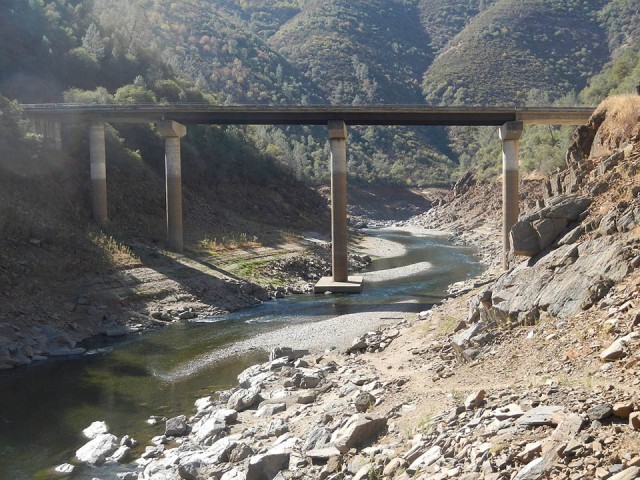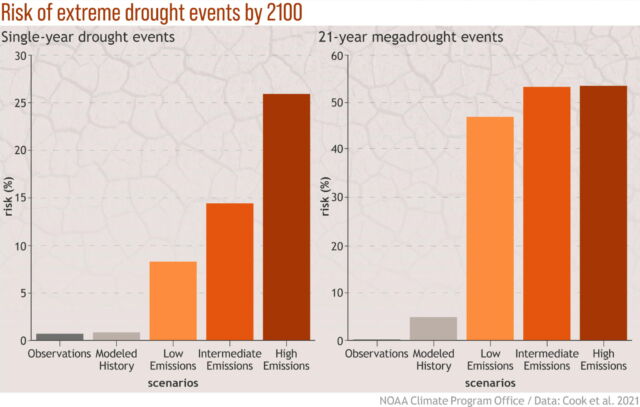The surge in the average global temperature during the last 18 months has also taken some climate scientists by surprise, raising the question of whether the rate of warming is faster than projected by the IPCC, and whether that will push parts of the climate system past dangerous tipping points in the near future.
The answer varies depending on exactly which segments of time are compared. But some researchers, like former NASA scientist James Hansen, have said that accelerated warming will push the planet’s average temperature past the target of the Paris Agreement of limiting human-caused warming to well below 2° Celsius above the pre-industrial baseline by 2050.
With many signs pointing out danger ahead, the findings of the new study emphasize the need for a reassessment of drought risks around the world and highlight the importance of correcting existing biases in climate models to increase confidence in their projections, Petrova said.
Those “systematic biases are known to contribute to divergence in model projections of dry extremes,” the scientists wrote. The new study, integrating detailed observations of dry spells from 1998 to 2018, aims to narrow those gaps to make more accurate drought projections.
Simultaneous wet and dry extremes
Michael Mann, director of the Center for Science, Sustainability & the Media at the University of Pennsylvania, said there is plenty of research showing that climate models fail to resolve some of the processes that are involved in summer season extremes, including floods, heat waves and droughts.
One of the big challenges is that models can’t fully recreate some of the physical processes that cause rainfall deficits, and they show big differences in the strength of relevant climate feedbacks, like soil moisture and clouds.
“We argue that the models are underestimating the impact that climate change is already having on these extreme events,” said Mann, who was not involved in the new research. “So it isn’t surprising that an approach that weights models by their ability to match real-world patterns projects greater extremes.”
The World Meteorological Organization warned in 2019 about simultaneous wet and dry extremes. Mann said it’s not a contradiction to see both more extreme rainfall and worse drought.
“When it does rain, there’s more rainfall in any given event, in part because a warmer atmosphere holds more moisture, moisture that can be converted into rainfall,” he said. “But rainfall events are fewer and far between, and warmer soils lose more moisture through evaporation,” which leads to longer spells of drought between rainfall.
In recent years, simultaneous extremes have been evident at global and regional scales during every season, over land and across the oceans. During the last few days in Europe, multiple forest fires erupted in Portugal after summer heatwaves and drought, while at the same time, parts of Poland, Czechia, Romania, and Austria went from the hottest summer ever measured to an extreme extended rainstorm with deadly flooding in a matter of days.
“The catastrophic rainfall that hit Central Europe is exactly what scientists expect with climate change,” said Joyce Kimutai, a researcher at the Grantham Institute at Imperial College London who is part of a World Weather Attribution team assessing the role of global warming in the floods.
“A warmer atmosphere heated by fossil fuel emissions can hold more moisture, leading to heavier downpours,” she said. “Weather station data also indicates that bursts of September rainfall have become heavier in Germany, Poland, Austria, and Czechia.”
She added: “We are on track to experience more than 2.5° Celsius of warming before 2100, so we need to adapt to the impacts of extreme weather that is occurring more and more frequently. We need to stop burning fossil fuels, but we cannot forget about adaptation.”
It’s clear that even highly developed countries are not safe from climate change, added Friederike Otto, also a climate researcher at Imperial College London and a leader of the World Weather Attribution team.
“As long as the world burns oil, gas, and coal,” she said, “heavy rainfall and other weather extremes will intensify, making our planet a more dangerous and expensive place to live.”
This story originally appeared on Inside Climate News.













Comments